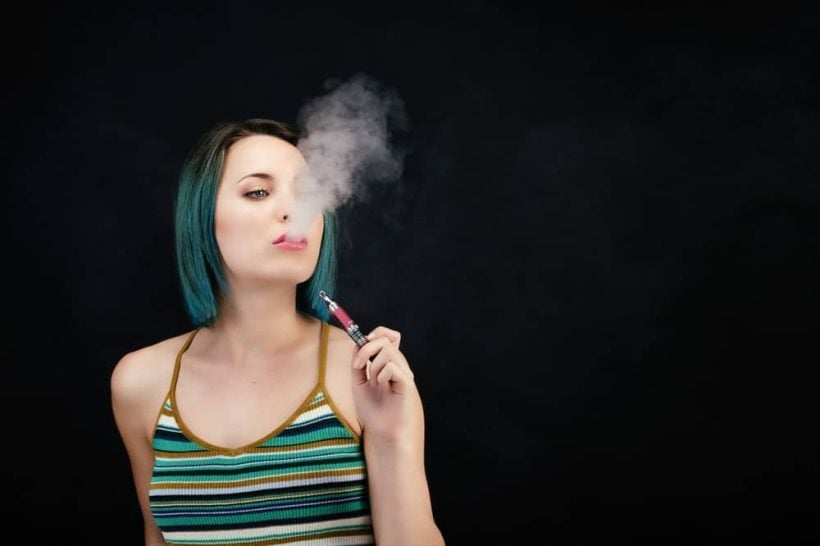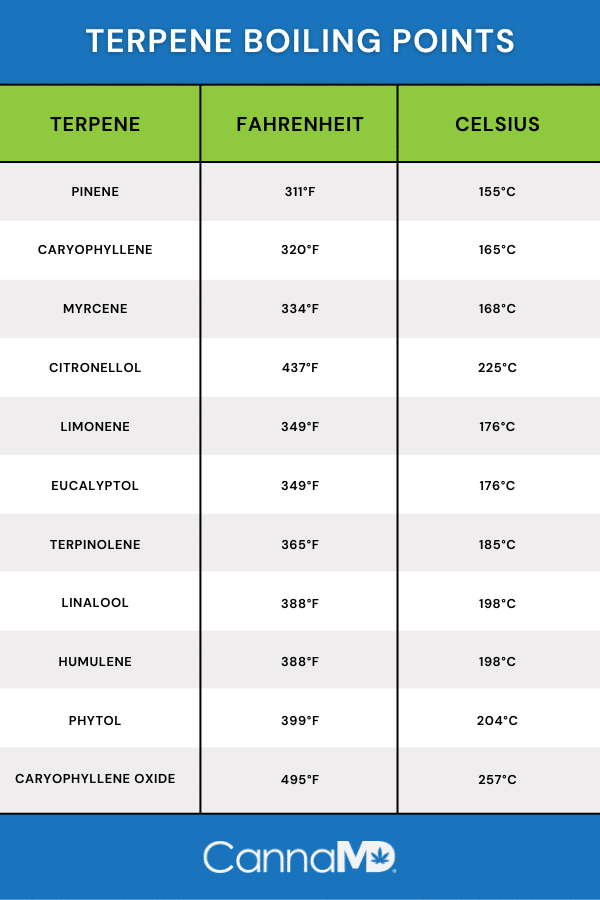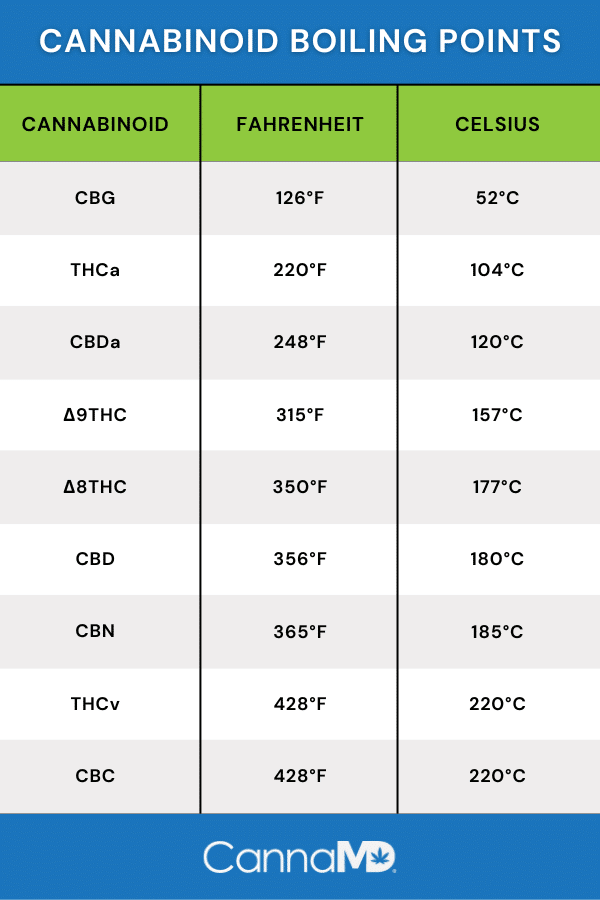Vaping has gained popularity due to its health benefits and smoother experience, making it a preferred method for consuming cannabis flower and concentrates. However, one often overlooked factor that significantly shapes the vaping experience is temperature. In this article, CannaMD explores the best temperatures for vaping marijuana and how they can affect your experience as a medical marijuana patient.
Why does marijuana vaping temperature matter?
The temperature you vape at in large part determines what you’re even inhaling. The effects, flavor, and quality of cannabis are determined by the varieties and quantities of cannabinoids and terpenes. These molecules all have different evaporation points, and the temperature at which you vape determines which combination of cannabinoids and terpenes you end up with, thus influencing your weed’s properties and flavor. By adjusting the temperature, you can selectively activate these compounds, influencing the flavor, aroma, and effects of your vaping session.
Low-Temperature Vaping Benefits
For a gentle, flavorful experience, consider vaping at temperatures between 325-350°F (163-177°C). At these lower temperatures, the vapor remains cool and less harsh on the throat, reducing the likelihood of coughing. This range is ideal for those who savor the terpene-rich, fresh, and citrusy flavors of cannabis.
Advantages:
- Light euphoria, calming, invigorating effects
- Intense terpene flavor
- Cooler vapor, reducing coughing
- Decreased side effects such as lethargy, anxiety, red eyes, and dry mouth
- Suitable for newcomers, lightweights, and flavor enthusiasts
- Ideal for staying productive and accomplishing tasks
Terpenes & Cannabinoids: pinene, caryophyllene, myrcene, limonene, eucalyptol, Δ8THC, Δ9THC, CBD, CBG, THCa, CBDa
Medium Temperature Vaping Benefits
The temperature range of 350-400°F (177-204°C) strikes a balance between terpenes and cannabinoids, offering a thicker and warmer vapor. This provides a richer flavor profile, making it satisfying for those transitioning from smoking to vaping. With more THC volatilized, you’ll experience stronger psychoactive effects without feeling overly drowsy. However, minor side effects may be more noticeable in this range.
Advantages:
- Relaxing, euphoric, and meditative effects without inducing sleepiness
- Flavorful and rich, combining terpenes and cannabinoids
- Warmer vapor for smokers seeking a satisfying experience
- Increased availability of cannabinoids
- Minor side effects possible
Terpenes & Cannabinoids: limonene, terpinolene, linalool, humulene, Δ8THC, Δ9THC, CBD, CBN, THCa, CBDa
High Temperature Vaping Benefits
For those seeking maximum cannabinoid extraction and the most intense psychotropic effects, temperatures between 400-430°F (204-221°C) are the way to go. Vapor in this range is hotter and less flavorful, making it suitable for nighttime sessions that may induce lethargy or “couch lock.” Be cautious, as many terpenes will deplete rapidly, and this temperature range can still induce coughing.
Advantages:
- Intense effects, strong euphoria, and potential couch lock
- Maximum THC volatilization
- Hotter vapor may lead to coughing
- Higher cannabinoid extraction
- Activation of THCv and humulene, appetite suppressants that can prolong “the munchies”
- Closest experience to smoking without combustion
Terpenes & Cannabinoids: citronellol, humulene, phytol, caryophyllene oxide, Δ8 THC, Δ9THC, CBD, CBN, CBC, THCa, CBDa, THCv
What temperature should a vape be to activate terpenes?
The optimal vaping temperature for terpenes depends on which ones you are trying to activate. The general range, however, typically falls anywhere between 300°F and 500°F. Below is a chart of some of the most popular terpenes and their activation temperatures (boiling points) in both Celsius and Fahrenheit:
What temperature should a vape be to activate cannabinoids?
The optimal vaping temperature for cannabinoids also depends on which ones you are trying to activate. The general range, however, typically falls anywhere between 126°F and 428°F. Below is a chart of some of the most popular cannabinoids and their activation temperatures (boiling points) in both Celsius and Fahrenheit:
What temperature should flower be vaped at?
When it comes to vaping flower or dry herb, the temperature settings for different doses share some similarities with concentrates. The lower temperatures offer a diverse cannabinoid profile, while the hotter the temperature gets, the more potent the THC will be. For a gentle experience, you’ll want to stay within the range of 320–356°F (160–180°C), which is considered a light dose. Stepping it up a notch, a medium dose typically falls between 356–392°F (180–200°C ). If you’re aiming for a more intense high, anything at or above 392°F (200°C) qualifies as a high dose.
What temperature should resin be vaped at?
The ideal temperature for vaping resin typically falls between 500°F and 600°F. By using temperature monitoring tools or mastering the art of precise heat control, you can ensure your resin experience is a terpene-rich delight. If you’re craving an extra burst of flavor, keeping the temperature below 550°F is often the sweet spot.
What is the best temperature for a dab pen?
When it comes to standard dabbing temperatures, the range typically falls between 500°F and 600°F, especially for users employing battery-powered or electronic vaporizers. Adjusting within this range can yield variations in flavor and effect since different cannabinoids and terpenes in the strain vaporize at different temperatures. This results in diverse effects and flavor profiles depending on your chosen temperature range.
Given that most available cannabis concentrates are THC-rich, the dominant compound in your dab will be THC. However, the temperature you select will determine which terpenes accompany the THC, influencing the overall flavor and experience.
Low-Temperature Dabbing Range: 400 – 450°F
For those who wish to savor the terpenes in their concentrates, the low-temperature dabbing range of 400-450°F is ideal. This temperature is particularly suited for concentrates with a high terpene content, as terpenes vaporize predominantly between 270°-390°F. Dabbing below 450°F allows you to experience the full flavor profile of a strain, resulting in a gentle, gradual high.
- 400°F: Typically the lowest setting on dab pens, this temperature emphasizes terpene vaporization over cannabinoids. It provides a flavorful experience with a milder high.
- 450°F: Either the lowest or second-lowest setting on most dab pens, this temperature balances vapor production and terpene retention, resulting in pronounced flavor and noticeable psychoactive effects.
Mid-Range Dabbing Temperature: 500 – 550°F
The mid-range of dabbing temperatures, ranging from 500-550°F, is favored by regular dabbers seeking a balanced experience. This temperature range strikes a harmony between flavor and psychoactive effect, producing a satisfying vapor output.
- 500°F: A sweet spot for many seasoned dabbers, this temperature retains full flavor and vaporizes the oil efficiently, resulting in a well-rounded, rapid-onset high.
- 550°F: Towards the higher end of the midrange, this temperature begins to degrade more cannabinoids and terpenes. While it offers a thicker vapor, some terpenes are lost, and psychoactive effects become more pronounced.
High-Temperature Dabs (600°F+)
Dabbing at temperatures exceeding 600°F is generally considered less enjoyable and potentially harmful. At these extreme temperatures, harmful compounds can form as certain constituents in the cannabis extract begin to burn. The thickness of the vapor is partly attributed to this combustion, which detracts from the desired vaporization experience.
Dabbing at these high temperatures can also pose health risks, as the harsh, hot vapor can damage lung tissue and lead to respiratory issues. The loss of flavor and unpleasantly heavy effects make high-temperature dabs less favorable. This caution applies especially to traditional concentrates like water hash, where tiny plant particles can burn, impairing the overall dab flavor.






